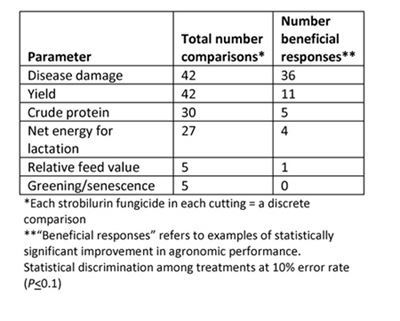Updated Analysis On Fungicides And Alfalfa
DR. PAUL VINCELLI
DR. RAY SMITH
LEXINGTON, KY.
Last year, Headline® fungicide received a federal label for control
of foliar diseases of alfalfa for use on seed, for hay, or for silage
(with a 14-day pre-harvest interval in all cases). See additional label
restrictions.
The April 9, 2013, issue of Kentucky Pest News included an article on
the overall performance of Headline® fungicide based on public field
research. The present article includes updated tables of field
performance. These tables include all the data from the previous
article plus two additional sources:
• UK field research conducted this past summer;
• A paper1 on fungicide performance recently published by researchers in Wisconsin.
Updated summary of public research
The results of our analyses are shown in the table below, and key points are summarized here:
• In almost all comparisons, applications of strobilurin fungicide reduced damage from foliar/stem diseases.
• In spite of the reduction in disease damage, yield increase was
observed in only 11 of 42 comparisons. Most of those yield increases
occurred in the first or second cuttings, consistent with manufacturer
reports. When they occurred, yield increases were almost always in the
range of one- to three-tenths of a ton of dry matter per acre.
• Forage quality (measured in various ways; see table) was improved
in very few comparisons. It is important to note that there were also a
number of instances where quality was slightly reduced in the
fungicide-treated alfalfa (data not shown, available on request).
• The physiological “greening” effect of strobilurin fungicides was
not reported in alfalfa in experiments where such observations were
included in the report.
*Each strobilurin fungicide in each cutting = a discrete comparison
**“Beneficial responses” refers to examples of statistically
significant improvement in agronomic performance. Statistical
discrimination among treatments at 10 percent error rate (P<0.1)

Conclusions
It seems clear that application of a strobilurin fungicide very
commonly reduces levels of foliar disease in alfalfa in humid regions of
the USA. However, in research thus far, strobilurin fungicide was
associated with increased forage yield in only about 25 percent of
comparisons. Yield increases, when they occurred, almost always were in
the first or second cutting. This may be because the fungus that causes
spring black stem and leaf spot, which is most active in these earlier
cuttings, is highly sensitive to Headline®. In any case, if considering
the use of fungicide, best results will be obtained by applying during
the growth phase of the forage for the first or second cutting.
Forage quality has been minimally improved by strobilurin fungicides
in research thus far. This latter finding surprises us, because leaves
represent high-quality forage, and we would expect that improved leaf
health would translate to improved forage quality. Continuing research
is advisable, since several of the growing seasons of these tests were
unusually hot and dry; results economically favorable to fungicide use
could occur in wet growing seasons.
1Samac et al, 2013. Evaluating Headline Fungicide on Alfalfa
Production and Sensitivity of Pathogens to Pyraclostrobin. Online. Plant
Health Progress doi:10.1094/PHP-2013-0917-01-RS.∆
DR. PAUL VINCELLI: Extension Plant Pathologist, University of Kentucky
DR. RAY SMITH: Extension Forage Agronomist, University of Kentucky